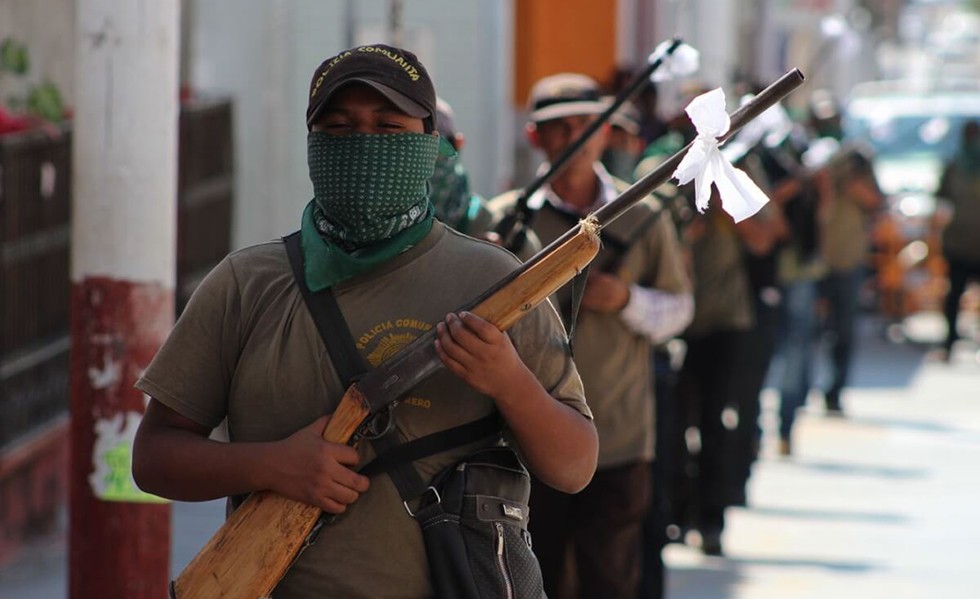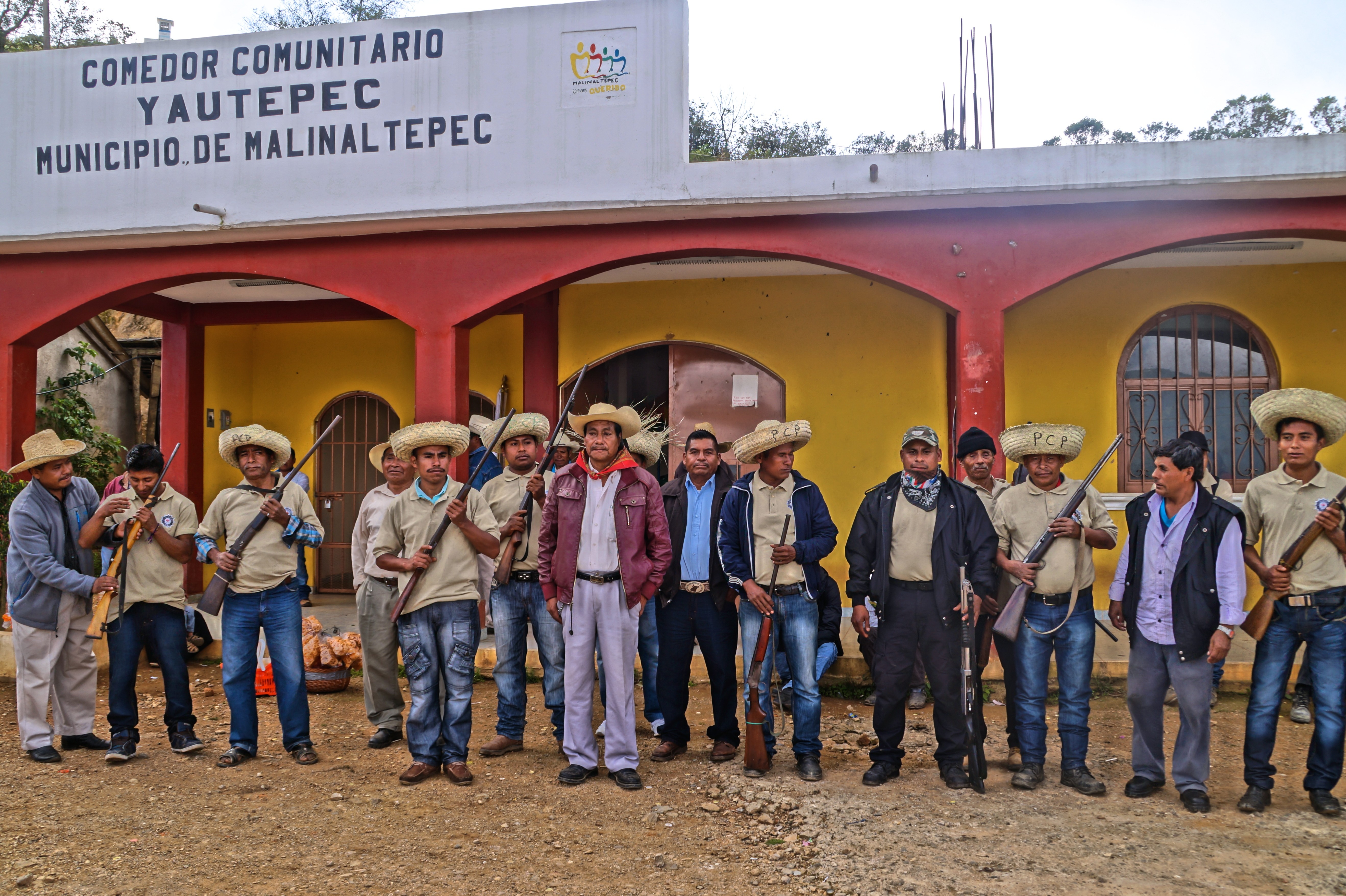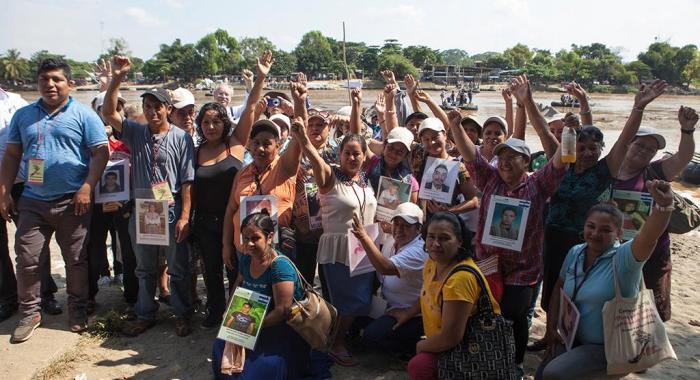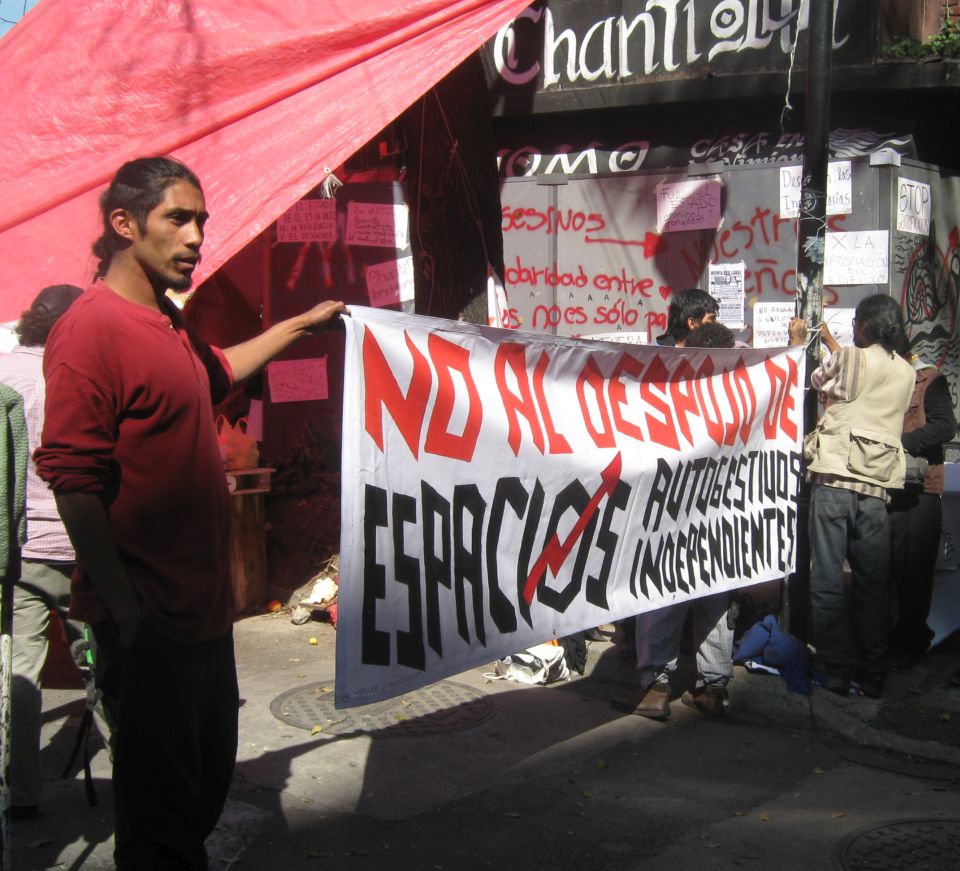Filed under: Editorials, Insumisión, Mexico

Originally published to It’s Going Down
By Scott Campbell
As those of us in the U.S. come together to plan for the incoming Trump regime, hopefully we can find some inspiration and affinity with the ongoing resistance happening in Mexico. After this summer’s teachers’ strike and popular mobilizations collapsed, communities and organizations in Mexico have returned to the essential but none-too-glorious work of building community self-defense and organization to maintain their gains and prepare for the next uprising that will inevitably occur.
This edition looks at communities around Mexico creating and defending autonomy, taking matters into their own hands to provide for their security from the state, organized crime and corporations. There are also updates on prisoners, community media and Ayotzinapa. This will probably be the final Insumisión of 2016. Since starting in March, we’ve put out 14 of them and appreciate that people find them useful. In 2017, we are hoping to expand our Mexico coverage and part of that will be a trip I am planning to take in a couple of months to connect face-to-face with many of the organizations you read about in these columns and to produce exciting original content. To help make that happen, please contribute to and spread the word about our fundraiser for the trip.
Community Self-Defense
CRSJ-PCP in Alacatlatzan, Guerrero.
The recent months, communities in western Michoacán have seen increased violence as the Knights Templar cartel reorganizes. The cartel was effectively run out of the area beginning in 2013, when armed self-defense groups began forming and reclaiming cartel territory. But the self-defense movement was quickly repressed, coopted, and divided by the government, leading the cartel to again assert itself. Meanwhile, the state has turned a blind eye to cartel violence while targeting indigenous community leaders. In response, on November 10, several communities and self-defense groups blockaded a federal highway and took over local government offices in the towns of Coahuayana, Chinicuila, and Aquila. In a joint statement, they said,
We make it clear that the security of our communities is not under negotiation. There are deaths in our municipalities, those whom are assassinated and disappeared, violations of women, families extorted and destroyed, thousands of people in the region who are displaced by criminal violence, communities displaced of their sacred lands, minerals, and precious trees that are in danger of extinction. This speaks to our staunch determination that the death and violence will not return to our municipalities and communities.
A day later, the government met with members of the movement, though no resolution has been reached. Instead, the government has denounced them as criminals and used the negotiations to threaten the use of force if the blockades didn’t end.
Tired of insecurity and government inaction in an area with one of the highest crime rates in the country, one thousand residents in Iztapalapa in Mexico City got together to organize street-by-street community security without involving the police. They also hung banners threatening to kill any criminal they catch, which leaves a lot to be desired as a model for justice but so far that threat has not been carried out. Important context to understand such a response is that fact that, according to a report released earlier this year by the Inter-American Human Rights Commission, 98 percent of crimes in Mexico go unpunished. This is not to argue that the justice system should function more effectively, but rather to illustrate that impunity is the law.
In Cuetzalan, Puebla, communities similarly tired of crime decided protesting in front of city hall wasn’t enough. On November 20, while marking the 106th anniversary of the Mexican Revolution, hundreds of residents, along with indigenous and farmer groups, overwhelming agreed to form community patrols. Then, for good measure, they marched to the construction site of an electricity substation and announced they were shutting it down permanently, as it was being built without permission and the high-tension wires posed a health risk.
Funeral of CRAC-PC leader Irineo Salmerón Dircio.
In October, the Regional Coordinator of Community Authorities – Community Police (CRAC-PC) celebrated 21 years of existence. The CRAC-PC operates in 153 indigenous communities in Guerrero and numbers around 2,000 members. Contrary to how the police function in the U.S. and most of Mexico, the CRAC-PC operates as a replacement to the municipal police and local justice system. Groups are formed based on agreement within each community’s assembly. The police are members of the community who are appointed in a rotating manner to the position of “police” by the community assembly, are accountable to that same assembly, and can be removed from their position at any time. While the CRAC-PC has seen some divisions and incidents of government cooptation, overall, anti-social transgressions have dropped drastically in their areas of operation, and as necessary the CRAC-PC mobilizes to defend the community’s interests against organized crime, corporations and the government.
As such, the CRAC-PC has experienced repression, including the imprisonment of leader Nestora Salgado, who was freed in March, and three other members who have been imprisoned for three years so far. More recently, CRAC-PC leader and teacher Irineo Salmerón Dircio was kidnapped on November 23 in Tixtla. In response, the CRAC-PC blockaded a federal highway in two locations. His body was found two days later. Then on November 28 in Tixtla, activist Luis Tenero Encarnación was kidnapped and found shot to death on November 30. Additionally, an organized crime group – The Bosses (Los Jefes) – who claimed the murder of Irineo, announced an 11pm curfew in Tixtla. Following these developments, the CRAC-PC held an armed march through town, joined by fellow Tixtla residents. They said, “The first message we are sending is one of peace, it is not a message of war. But we are also saying that in spite of all the attacks against us, we are not going to disarm and we will remain in the struggle.”
Also in Guerrero, Ruptura Colectivo takes a look at the Regional Coordinator for Peace and Justice – Citizens and Peoples Police (CRSJ-PCP), which celebrated it’s fourth anniversary and the formation of a new branch in the community of Alacatlazala. “So long as there is injustice, the people will continue to organize. As Naa’ Savi people, we have decided in assembly to form our own system of indigenous security and justice.”
Mobilizations and Repression in Chiapas
Gathering during the MODEVITE pilgrimage in Chiapas.
On November 15, members of eleven municipalities in Chiapas began a twelve-day pilgrimage through communities threatened by neoliberal development projects, ending in San Cristóbal. The Movement in Defense of Life and Territory (MODEVITE) is a project of indigenous Catholic parishes practicing liberation theology, known the Pueblo Creyente, or Believing/Faithful People. “We seek to organize the peoples to construct our autonomy; that our right as original peoples to the life that we want is recognized. We need to join our voices in defence of our forests, our rivers. We demand the governments stop the extractive industry and the mega-projects that are being imposed without consulting us,” said one priest.
After traveling through 11 states, the Caravan of Mothers of Disappeared Migrants wrapped up their eighteen-day tour in Tapachula, Chiapas on December 3. Forty-one parents from Central America made the trip to call attention to the attacks, murders and disappearances of Central American migrants in Mexico and to denounce Enrique Peña Nieto’s Southern Border Plan, implemented at the behest of the U.S. in 2014, which has gravely increased the risk to migrants traveling through Mexico.
Caravan of Mothers of Disappeared Migrants
In the autonomous indigenous communities of Ejido Tila and San Sebastian Bachajón, statements have been issued decrying attempts by local politicians to incite violence in the communities in order to justify the entrance of the state in order to crush their autonomous projects. In Bachajón, the community has identified Juan Jiménez as the one responsible. As it happens, Jiménez is a local leader of MORENA, the “leftist” party of Andres Manuel López Obrador. In Tila, the community has barricaded the entrance to the village to prevent paramilitaries or provocateurs from entering.
During a meeting to resolve a labor dispute in Ixtacomitán, four teachers belonging to the dissident CNTE branch were shot by gunmen linked to local politicians and the mainstream, sell-out SNTE union. Roberto Díaz Aguilar was killed and the three others wounded.
And of course we can’t talk about Chiapas without mentioning the Zapatistas. They’ve released four statements – two jointly with the National Indigenous Congress – in the past three weeks. The first, “It’s Not the Decision of One Person”, is an angry rebuke to mainstream critics of their proposal to run a presidential candidate for 2018. The second outlines the schedule for the conclusion of consultations and the planned announcement on the decision of whether or not to run a candidate. The third is a lengthy “Story to Try to Understand.” At over 30 pages, I have not read it yet, but it is an explanation as to how the Zapatistas arrived at the decision to propose the idea of participating in the presidential elections. The fourth statement denounces the attacks on indigenous peoples in Mexico, and gives a nod to Standing Rock, all while confirming that the community consultations over the proposal continue.
Oaxaca Welcomes its New Governor
Teachers union blockade in Isthmus of Tehuantepec, Oaxaca
Alejandro Murat of Peña Nieto’s PRI party became Oaxaca’s new governor on December 1, but it didn’t happen all that smoothly. Murat is the son of former PRI governor José Murat Casab, described by Mexico scholar Edward Gibson as “one of most authoritarian governors in recent memory.” His election brings the state back under PRI control, as it has been since 1929 with the exception of the past six years of Gabino Cué’s regime.
Massive mobilizations were planned to block Murat from taking office, but the state had plans of its own. A caravan of 700 people from the southern mountains was heading to the city of Oaxaca until it was overtaken by a logging truck on a highway outside of Miahuatlán on November 28. The truck blocked the road and the crew got out, first cutting the truck’s wires and then shooting out its tires. Eventually, the caravan was able to move the truck off the road and advance, only to run into a state police blockade a little later. The 300 police shut down the entire highway just to stop the caravan, eventually letting them pass more than 12 hours later.
In the city of Oaxaca, the Confederation of Mexican Workers (CTM), a grouping of unions created by and loyal to the PRI, declared they were ready to fight the teachers and anyone else protesting Murat’s inauguration. They set up blockades to keep protesters away and the state’s human rights commission issued an “early alert” over the possibility of violence. Not to be outdone by the CTM, the CNTE teachers union erected 37 blockades throughout the state on November 30 and were also able to tear down the fences put up outside the state congress to keep protesters out.
Hopefully feeling a bit like Trump will on January 20, Murat cancelled the public inauguration and took the oath of office before dawn on December 1, hidden away in the offices of the state television channel. Later that day, he tried to walk through the Zócalo, only to be heckled by cries of “murderer!” and more from growing crowds.
.@alejandromurat sale a las calles de Oaxaca y lo reciben con consignas en su contra. pic.twitter.com/bhOkX4q9AD
— Alexis Añorve (@appo_stol) December 2, 2016
In a bit of other news from Oaxaca, five thousand people marched in Zanatepec, in the Isthmus region, on November 20 to support the decision to declare the municipality a “mining-free zone” and to reject the five mining concessions imposed by the federal government that would impact 30,000 hectares of the communities’ lands. And like the Zapatistas, a variety of indigenous and civil society groups in Oaxaca released a statement in support of the Standing Rock Sioux and the resistance against the Dakota Access Pipeline.
Media Production and Repression
Compas are working on setting up an autonomous, self-managed online TV station and put out their first test program in November. Keep an eye out to see how this project develops.
Just hours before she received the Knight International Journalism Award, five individuals broke into the media offices of Carmen Aristegui in Mexico City on November 13 and stole a laptop. Though a commercial journalist, Aristegui has consistently been a thorn in the side of the current government. On November 18, photojournalist Mario Delgadillo Ramos was shot and killed outside his house in Tezoyuca, State of Mexico. And on November 24, in La Cumbre, Puebla, the indigenous Tlayole community radio station was attacked. Two members broadcasting live were beaten, while a third who came to help was shot in the chest and fortunately survived. The attackers have links to local authorities, with one being a relative of the mayor.
Lastly, a short documentary, with English subtitles, has been released about Salvador Olmos García, an anarchist and journalist from Huajuapan, Oaxaca, who was killed by police on June 26.
Prisoners
In some good news, Roberto Paciencia, an indigenous political prisoner and adherent to the Sixth Declaration in Chiapas, was released after being held for three years. And It’s Going Down has English translations of letters from three anarchist prisoners. Miguel Peralta, on the anniversary of the assassination of Ricardo Flores Magón; Abraham Cortés on rebellion and a name change to SERCKO; and, Luis Fernando Sotelo after he and activist Jesse Montaño were beaten by guards. Check them out!
Ayotzinapa
In news related to the 43 disappeared students from Ayotzinapa, the Special Follow-up Mechanism arrived in Mexico on November 11. It is the second commission sent by the Inter-American Commission on Human Rights (IACHR) and is tasked with ensuring that the recommendations outlined by the first commission – the International Group of Independent Experts, which was run out of the country by the federal government – are adhered to by that same government.
Just in the past month, the government has displayed its commitment to truth and justice by appointing Omar Hamit García as head of the Criminal Investigation Agency. Hamit has documented connections to the Guerreros Unidos cartel, implicated in the Ayotzinapa disappearances. He replaces Tomás Zerón, who was promoted by Enrique Peña Nieto following Zerón’s success in blocking the first IACHR investigation. On December 2, Peña Nieto also promoted Alejandro Saavedra Hernández to Federal Inspector and Comptroller General. Saavedra was previously an Army general and head of the 27th Infantry Battalion in Guerrero. That battalion is similarly implicated in the disappearances. In fact, a new book reveals that according to leaked government documents, the students were disappeared by the 27th Battalion on the orders of a cartel after the students unwittingly commandeered buses with $2 million worth of heroin hidden onboard.
In Brief
A few other pieces of news to round out this edition. An anti-fascist march on November 19 in Mexico City was attacked by police with one anarchist participant arrested but who was later released.
ALERTA El golpeador @ManceraMiguelMX comienza a reprimir marcha antifascista en México, compa Jaime de Cruz Negra Anarquista detenido pic.twitter.com/AYKGo66aQM
— Saboteamos. Pro #BDS (@saboteamos) November 19, 2016
On November 19, there were actions around the U.S. and Mexico to protest Driscoll’s Berries and the exploitation of 80,000 farmworkers in San Quintín, Baja California. The protests demanded Driscoll’s negotiate and sign a collective bargaining agreement with the workers’ independent union. Relatedly, a new report cites Mexico as the country in the Americas with the highest level of modern-day slavery.
Jornada global d apoyo a jornaler@s d #SanQuintín
Contra la explotadora Driscoll's ?#BoycottDriscolls#ThanksGiving pic.twitter.com/ZCAPrY4gMx— Compa Liliana (@Loe_25sept) November 21, 2016
Encampment outside of Chanti Ollin in Mexico City
Hundreds of riot police carried out a pre-dawn raid on Chanti Ollin, an autonomous cultural and organizing space in Mexico City on November 22. Twenty-six people, including a three year old, were detained. All were released shortly after, except for one international who was deported. The space remains walled off and inaccessible. An encampment has been set up outside the building and on December 4, a Forum for the City of Those From Below was held to organize against ongoing gentrification and repression in the city.
Protests occurred around Mexico on November 25, the International Day for the Elimination of Violence Against Women. Below is some footage from a march in Oaxaca. As well, the Third Assembly of the Women’s Movement in Defense of Territory, meeting in Chiapas, released a statement on that day condemning the “patriarchal capitalist system.”
Fond of the pre-dawn raid, 300 Mexico City riot police attacked an encampment in Pedregales, Coyoacán at 3:45am on December 5. The encampment had been in place since April of this year to stop a real estate company from building on open space in the neighborhood, which includes the area’s source of water that is slated to fall under the private control of the company. Throughout the day, residents battled with police and attempted to block construction equipment from entering the area.
#AlertaPedregales en este momento están agrediendo a los compañeros de .@VecinoPedregals exigimos a @ManceraMiguelMX alto a la represión pic.twitter.com/xkZ2TReBs2
— PLANTON X 43 (@PlantonxAyotzi) December 5, 2016
This edition’s bit of comedic ineptitude is brought to you by Public Education Minister Aurelio Nuño. Responsible for pushing Mexico’s neoliberal educational reform and crushing the teachers’ movement against it, Nuño seems like he could benefit from revisiting the fundamentals, as a child had to publicly instruct him on how to properly pronounce “to read” in Spanish. Thanks for lering!
No se dice ler…se dice leer. Tómala @aurelionuno ni hablar puedes y quieres enseñar a los profesores #NoSeDiceLer pic.twitter.com/c8YgAfUtl8
— Proyecto Ambulante (@proamboax) November 15, 2016










